 Warm sunlight on morning mist This is another photo from my latest trip out to Ministik. It was a gorgeous, calm morning: warm enough to be comfortable, but cool enough to keep the mosquitoes down and the mist rising from the lakes.
A few of my prints have come out with slight colour casts, usually a (very little) bit greenish, so I tried this one tonight as the colour of the rising mist is very important to the feel of the photograph. We’ll see how it turns out…
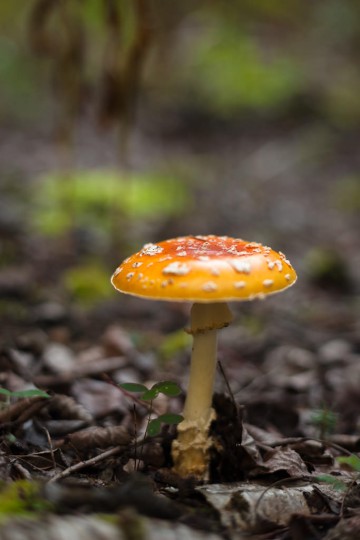 Fresh amanita mushroom Almost exactly two years ago (less one day), I had the opportunity to photograph a tremendous diversity of mushrooms at Ministik (click here to view a gallery of images). Today, I went back to the same spot and, while the diversity was much lower than the previous year, there were some great mushrooms out—and I had a great time photographing a few of them. This is a very fresh, still growing “Fly Agaric” or “Fly Amanita” mushroom (Amanita muscaria). Beautiful to look at—and photograph—but don’t eat it!
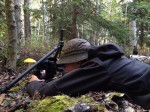 me photographing mushroom For most of the morning, I used my 50mm f/1.4 and flipped the centre column of my tripod upside down to make low-angled, shallow depth-of-field photographs of these mushrooms. I see mushrooms like this often while doing field work, but rarely have the time to take deliberate, careful photos of them. I’ll share a couple more from this morning in the next little while, so please come back again soon. (Here’s a quick photo of my hard at “work” this morning…)
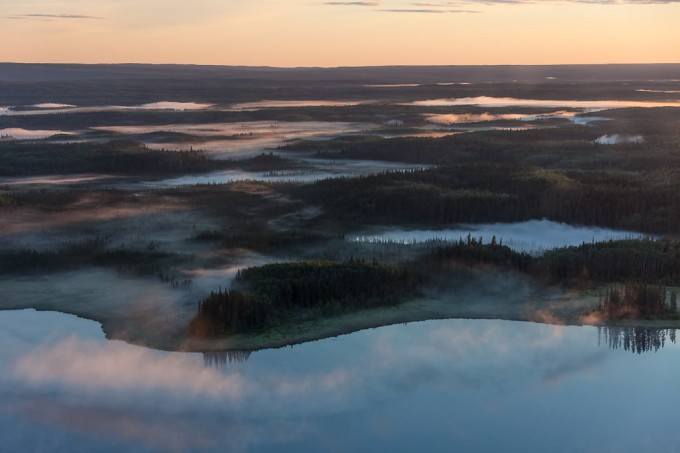 Morning fog over boreal lakes Here’s another photo that I took from the chopper on my way to work one morning last shift. It’s from a different morning as the previous photo, but from the same general area—near Namur Lake in northern Alberta (~100 km northwest of Fort McMurray).
This was a tricky image to print. I tried to get the balance right between detail in the shadows, but still having the landscape dark with just the top of the fog lightening as the sun first peaks over the horizon. It was also hard to figure out the right white balance to use—the Auto WB on my camera was quite cool (very blue shadows), and setting it to Daylight WB made everything very orange-y. I set a manual balance somewhere in the middle, leaning towards cool—does anyone know a good tip for setting white balance for sunrise/sunset so accurately represent how the scene was perceived at the time?
This’ll be my last post for a little while as I’m going up for another shift, but hopefully I will return with many more new photos to share!
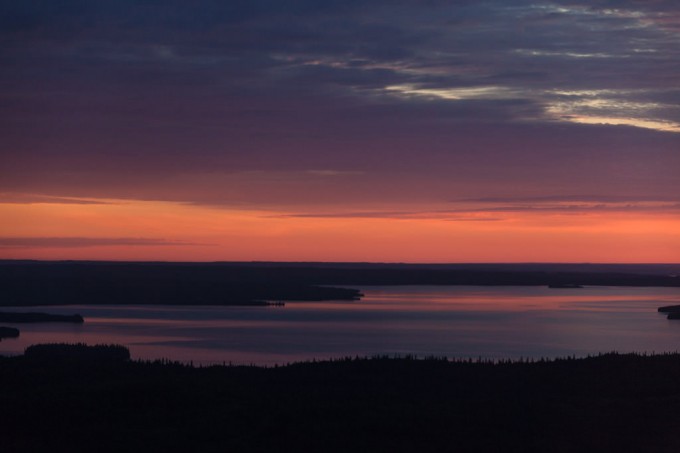 Sunrise over Namur Lake I took this photo on my way to work earlier this summer—I just happened to be lucky enough to be commuting in a helicopter out to a gorgeous old-growth boreal mixedwood site about 100km north-west of Fort McMurray to do bird surveys for the morning! It was a neat experience to get to spend so much time flying over the boreal landscape that I know so well from the ground, and to get a bit of a different perspective on things. I’m sure I’ll print and share here a few more photos from my past couple shifts up there.
I notice when I look through my photo archives, that my colour palette tends to be rather subdued, even sombre at times. If I then look through the photographs made by other photographers that I’ve marked as my favourites, (primarily on the terrific photography-sharing website 500px.com (here’s my 500px collection and my favourites from other 500px photographers)) I notice that the overall impression is very similar—I guess it turns out that’s just what I’m most drawn to… So, for today’s print I decided to choose an image with a bit of colour.
I chose this photo in particular because of the bright, highly saturated orange/red band on the horizon. When Lightroom 4 was released (the software I use for 95% of my processing), I’d read about its new soft-proofing ability (here’s another good article as a pdf), but never actually used it before. I was pretty sure the intense warm colours in this image would be out of gamut for my printer and paper combo that I’m using for this Daily Print project (an Epson 3880 and Canson Baryta Photographique). Sure enough, Lightroom was showing me clipping warnings, but with just a little finessing (lower saturation and highlights, increase vibrance and contrast, tweak tone curve, etc), I got it looking good, and not showing any clipping. I ran the print off, and was quite impressed how closely the print matched my monitor. I’m looking forward to seeing the print in the daylight tomorrow…
After my previous post “Athabasca Falls in black and white” with the motion of the water captured with a slow shutter speed to give a streaked effect, I remembered that I had also captured some video on that morning. So—for your interest’s sake—here is: a short video clip of Athabasca Falls shot at 30 fps with a shutter speed of 1/30th of a second at f/16; a still photo of the same composition captured at 1/5th of a second at f/8 and iso400 (the same settings as the image in my previous post); and a photo captured at 1/125th of a second (which I’ve been told best captures how our eyes/brains see motion) at f/9 and iso800.
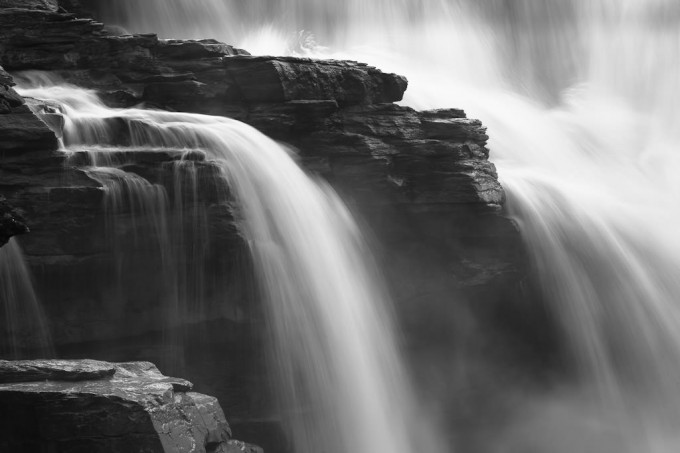 Athabasca Falls II (1/5th sec) 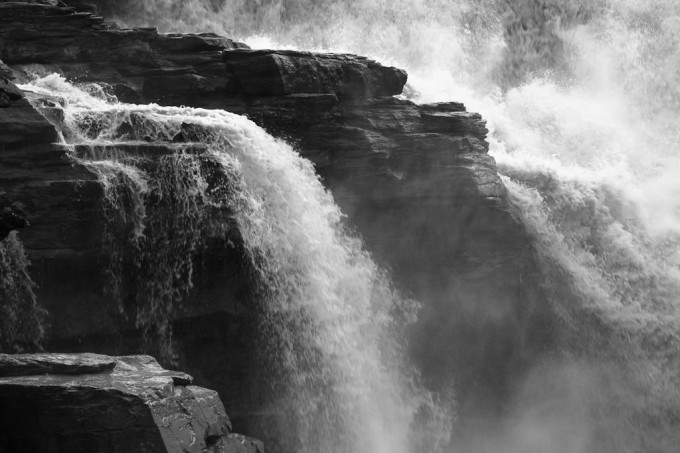 Athabasca Falls III (1/125th sec)
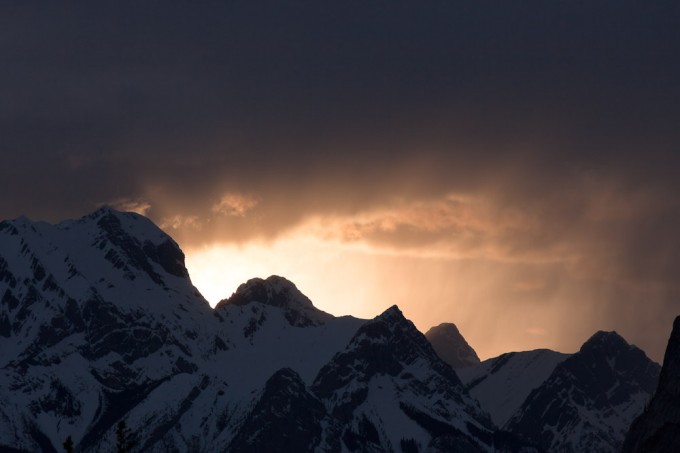 Sunset under heavy clouds If you’ve signed up for my newsletter you’ll recognize these past few images that I’ve shared—this one is from a trip to Jasper National Park that I took this spring. I was lucky enough to drive into the mountains just as the sun dipped below the clouds for a few minutes before sinking behind the mountain peaks. I don’t recall my camera settings for this particular image, but I was definitely thinking of the golden rule for landscape photography—“f/8 and be there”.
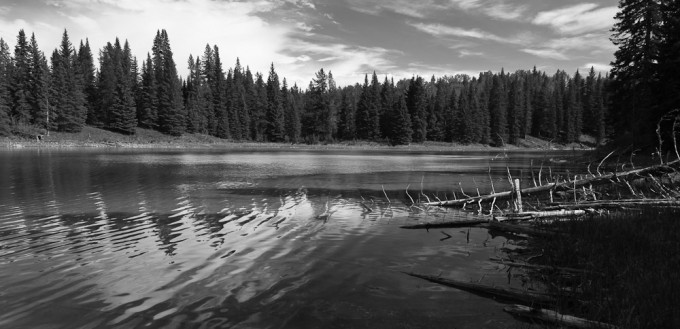 Greytones in boreal lake I took this photograph at one of the five lakes in Emerson Lakes Provincial Park, northwest of Edson, Alberta—a great little place that was almost completely deserted the weekend I was there. If you don’t mind a little bit of gravel road, I would definitely recommend this spot for a quiet boreal retreat.
Although the middle of the afternoon is not normally the best time of day for making photographs of the landscape, great photographs are still out there—and (if you ask me) any photographer that tells you otherwise isn’t looking hard enough. In this image, made at just past 4pm on a nice sunny day, I just love how the lake holds nearly the full range of tones from the nearly black shadows along the shoreline to the bright white reflections of the high cirrus clouds and the midtones of the shallow lakebed itself—all mixed together by the slight breeze causing the ripples on the water’s surface.
Add in a couple Bonaparte’s Gulls, a pair of Belted Kingfishers, and a chorus of songbirds—and you’ve got yourself a pretty good spot to sit for a while, making photographs as the clouds shift by (which is exactly what I did…)
|
(Click photos to enlarge)
|










